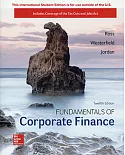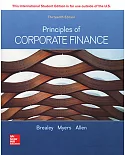PART I: OVERVIEW
Ch 1 Introduction to Corporate Finance
Ch 2 Financial Statements and Cash Flow
Ch 3 Financial Statements Analysis and Financial Models
PART II: VALUATION AND CAPITAL BUDGETING
Ch 4 Discounted Cash Flow Valuation
Ch 5 Net Present Value and Other Investment Rules
Ch 6 Making Capital Investment Decisions
Ch 7 Risk Analysis, Real Options, and Capital Budgeting
Ch 8 Interest Rates and Bond Valuation
Ch 9 Stock Valuation
PART III: RISK
Ch10 Risk and Return: Lessons from Market History
Ch11 Return and Risk: The Capital Asset Pricing Model (CAPM)
Ch12 An Alternative View of Risk and Return: The Arbitrage Pricing Theory
Ch13 Risk, Cost of Capital, and Valuation
PART IV: CAPITAL STRUCTURE AND DIVIDEND POLICY
Ch14 Efficient Capital Markets and Behavioral Challenges
Ch15 Long-Term Financing: An Introduction
Ch16 Capital Structure: Basic Concepts
Ch17 Capital Structure: Limits to the Use of Debt
Ch18 Valuation and Capital Budgeting for the Levered Firm
Ch19 Dividends and Other Payouts
PART V: LONG-TERM FINANCING
Ch20 Raising Capital
Ch21 Leasing
PART VI: OPTIONS, FUTURES, AND CORPORATE FINANCE
Ch22 Options and Corporate Finance
Ch23 Options and Corporate Finance: Extensions and Applications
Ch24 Warrants and Convertibles
Ch25 Derivatives and Hedging Risk
PART VII: SHORT-TERM FINANCE
Ch26 Short-Term Finance and Planning
Ch27 Cash Management
Ch28 Credit and Inventory Management
PART VIII: SPECIAL TOPICS
Ch29 Mergers, Acquisitions, and Divestitures
Ch30 Financial Distress
Ch31 International Corporate Finance





















